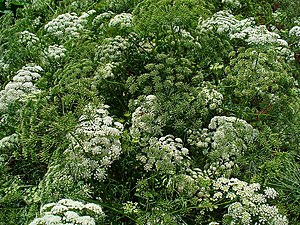Note: This is a project under development. The articles on this wiki are just being initiated and broadly incomplete. You can Help creating new pages.
Difference between revisions of "Ammi majus - Bishop's Weed"
| Line 66: | Line 66: | ||
<ref name="chemical composition">[https://www.researchgate.net/publication/306157342_Chemical_constituents_and_pharmacological_activities_of_Ammi_majus_and_Ammi_visnaga_a_review Chemistry]</ref> | <ref name="chemical composition">[https://www.researchgate.net/publication/306157342_Chemical_constituents_and_pharmacological_activities_of_Ammi_majus_and_Ammi_visnaga_a_review Chemistry]</ref> | ||
<ref name="Leaf">[Morphology]</ref> | <ref name="Leaf">[Morphology]</ref> | ||
| − | <ref name="How to plant/cultivate">[Cultivation]</ref> | + | <ref name="How to plant/cultivate">[https://pfaf.org/user/Plant.aspx?LatinName=Ammi+majus Cultivation]</ref> |
</references> | </references> | ||
Revision as of 12:23, 19 March 2020
Ammi majus is an annual plant with a much-branched stem. It can grows upto 30 - 150cm tall. The plant has a long history of herbal use going back to at least 2,000BC in Egypt and it is still in common use in modern herbalism. It is often cultivated for its attractive flowering stems which are sold in local markets and is cultivated in India and elsewhere as a medicinal herb.
Contents
- 1 Uses
- 2 Parts Used
- 3 Chemical Composition
- 4 Common names
- 5 Properties
- 6 Habit
- 7 Identification
- 8 List of Ayurvedic medicine in which the herb is used
- 9 Where to get the saplings
- 10 Mode of Propagation
- 11 How to plant/cultivate
- 12 Commonly seen growing in areas
- 13 Photo Gallery
- 14 References
- 15 External Links
Uses
Asthma, Angina, Leprosy, Kidney stones, Urinary tract infections, Toothache.
Parts Used
Root.
Chemical Composition
Ammispecies belong to the family Umbellifereae,contained bioactive compounds (mainly coumarins andflavonoids) of important biological activities.[1]
Common names
| Language | Common name |
|---|---|
| Kannada | |
| Hindi | |
| Malayalam | |
| Tamil | |
| Telugu | |
| Marathi | |
| Gujarathi | |
| Punjabi | |
| Kashmiri | |
| Sanskrit | |
| English |
Properties
Reference: Dravya - Substance, Rasa - Taste, Guna - Qualities, Veerya - Potency, Vipaka - Post-digesion effect, Karma - Pharmacological activity, Prabhava - Therepeutics.
Dravya
Rasa
Guna
Veerya
Vipaka
Karma
Prabhava
Habit
Identification
Leaf
| Kind | Shape | Feature |
|---|---|---|
Flower
| Type | Size | Color and composition | Stamen | More information |
|---|---|---|---|---|
| {{{5}}} |
Fruit
| Type | Size | Mass | Appearance | Seeds | More information |
|---|---|---|---|---|---|
Other features
List of Ayurvedic medicine in which the herb is used
Where to get the saplings
Mode of Propagation
How to plant/cultivate
Prefers a well-drained soil in a sunny position.[3]
Commonly seen growing in areas
France to Spain, South to Israel.
Photo Gallery
References
- ↑ Chemistry
- ↑ [Morphology]
- ↑ Cultivation
External Links
- Ayurvedic Herbs known to be helpful to treat Asthma
- Ayurvedic Herbs known to be helpful to treat Angina
- Ayurvedic Herbs known to be helpful to treat Leprosy
- Ayurvedic Herbs known to be helpful to treat Kidney stones
- Ayurvedic Herbs known to be helpful to treat Urinary tract infections
- Ayurvedic Herbs known to be helpful to treat Toothache
- Herbs with Root used in medicine
- Habit - Annual
- Index of Plants which can be propagated by Seeds
- Herbs that are commonly seen in the region of France to Spain
- Herbs that are commonly seen in the region of South to Israel
- Herbs
- Pages without herbs images


